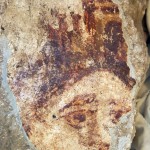Goddess of Fortune found in Sussita
 During the eleventh excavation season held by the University of Haifa a wall painting was found of Tyche, the Greek goddess of fortune. Also discovered was the relief of a maenad, a female companion of the god of wine, in the throes of a frenzied dance.
During the eleventh excavation season held by the University of Haifa a wall painting was found of Tyche, the Greek goddess of fortune. Also discovered was the relief of a maenad, a female companion of the god of wine, in the throes of a frenzied dance.
A wall painting (fresco) of Tyche, the Greek goddess of fortune, was exposed during the 11th season of excavation at the Sussita site which was conducted by researchers of Haifa University. Another female figure was found during this season of a maenad, one of the companions of the wine god Dionysus.
“It is interesting to see that although the private residence in which two goddesses were found was in existence during the Byzantine period when Christianity negated and eradicated idolatrous cults, one can still find clear evidence of previous beliefs”, said Professor Arthur Segal and Dr. Michael Eisenberg of the Zinman Institute of Archaeology at the University of Haifa, who headed the excavation. The city of Sussita is located within the Sussita National Park under the management of the National Parks Authority which has given much assistance during this season as well for the continuation of excavation work and for the conservation of the archaeological finds.
During the course of the excavations conducted by the team from the University of Concordia under the direction of Professor Mark Schuler in a residence that appeared, by the quality and complexity of its construction, to belong to one of the city notables, the excavators reached an inner courtyard with a small fountain at its center. Near the fountain they found a fresco of Tyche, who was apparently deified as the city goddess of fortune. Her head was crowned, her youthful gaze is focused, and she has abundant brown hair beneath her crown. According to the researchers, artistic analysis indicates that the wall painting may be dated to the end of the Roman period or the beginning of the Byzantine period (3rd – 4th centuries CE).
The goddess Tyche was not the only mythological figure to be discovered in this compound. Found on a bone plate was a wonderfully etched relief of a maenad, one of a group of female followers of Dionysus, the god of wine. According to Greek mythology, the maenads accompanied Dionysus with frenzied dances while holding a thyrsus, a device symbolizing sexuality, fertility, and the male sexual organ associated with sexual pleasure. The maenad of Sussita was also depicted as being in the midst of a frenzied dance. The researchers believe that both manifestations of the cult of Graeco-Roman female goddesses can be dated to the end of the Roman period, but there is no doubt that the residence in which they were found continued to exist even after Christianity triumphed over idolatry.
In this season the exposure was finally begun of the city’s Roman period basilica (1st – 2nd centuries CE), a large-sized building which incorporated the central commercial, social and judicial areas of the city. Besides the excellent architectural marble items that were unearthed, the researchers also found decorations made of “stucco”, molded plaster used in the imitation of marble. “We could not fail to wonder how a relatively plebeian city could employ first-class builders and artisans. The stucco decorations showed us that despite everything, the city rulers were certainly not sparing of the costs and expenditure of construction”, the researchers noted.
Sussita was erected on a mountain top rising to the east of the Sea of Galilee during the 2nd century BCE by the Seleucid rulers who then controlled the country. The city existed during the Hellenistic, Roman, Byzantine and Umayyad periods until it was destroyed by a violent earthquake in the year 749 CE. Together with Beth Shean and other cities on the eastern bank of the Jordan River, Sussita was one of the cultural-geographical group of Decapolis cities – a region within which Jesus conducted some of the miracles described in the New Testament.
University of Haifa
Division of Communication and Media Relations
Press Release
August 4, 2010
